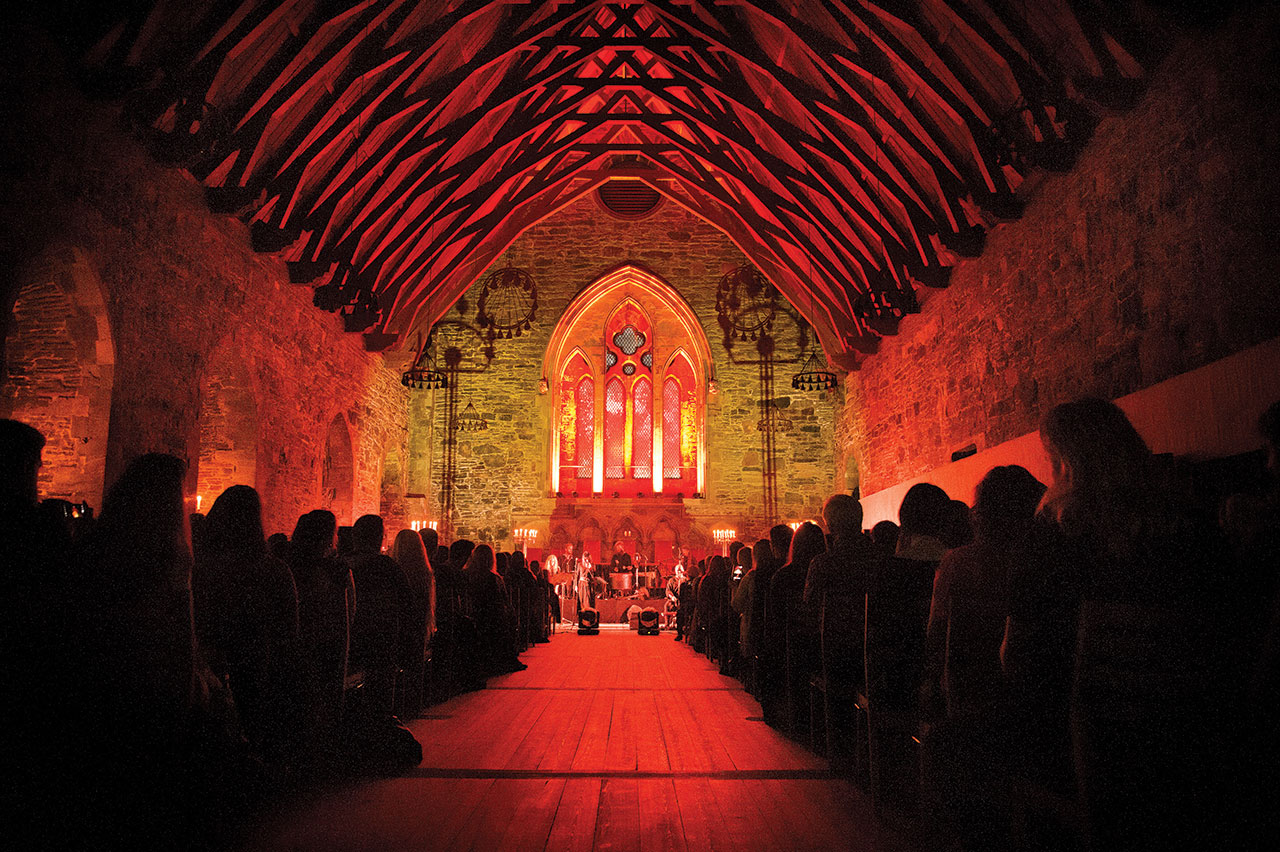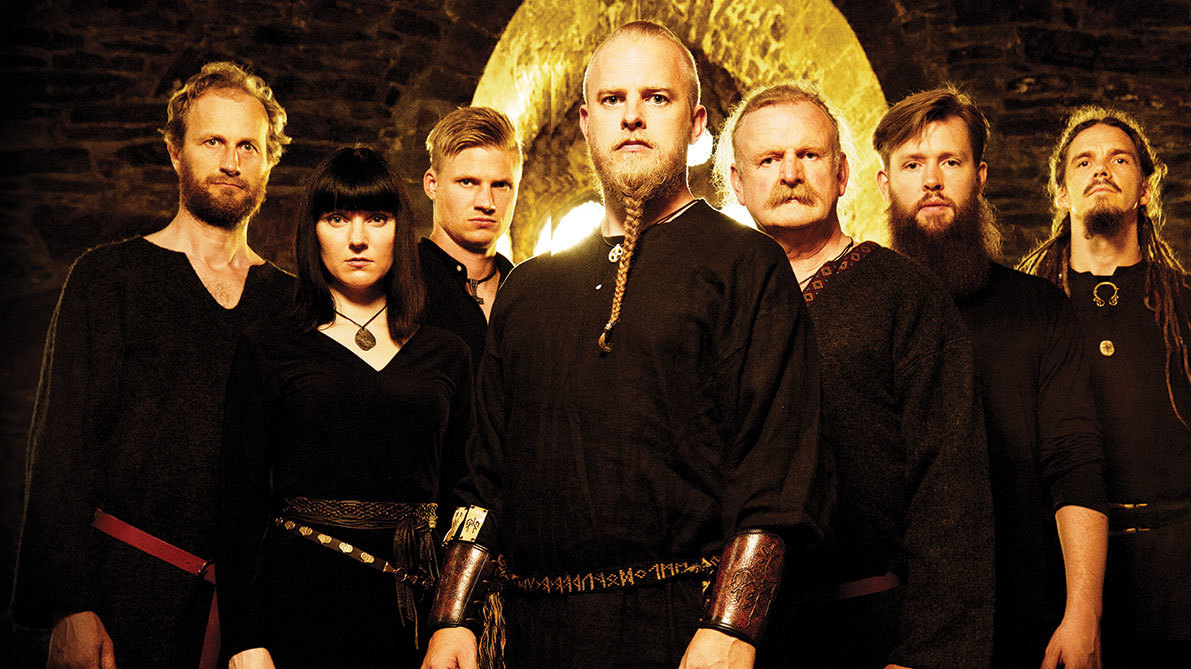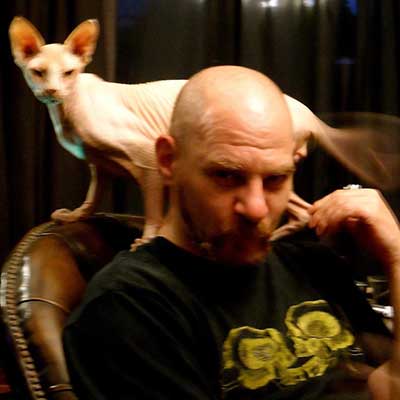Built in the mid-13th century when all around was water, the vast and vaulting royal dining hall known as Håkonshallen, along with a nearby defensive tower, is all that remains of the Bergenhus Fortress. It’s survived various fires, occupations by pirates and Nazi armies, not to mention 120 tons of dynamite that exploded on a German-operated ship in the nearby harbour, destroying the roof but leaving the main structure intact. It abides. To walk into Håkonshallen’s restored interior – amongst the echoing acoustics, hung, sigil-bearing tapestries and, at the back, huge arched window, dining table and chairs, holding negative space as if for a dynasty of giants that will surely one day return – is to realise that history has a mass, to sense that time here circulates to a different and more serious pulse.
To be hosted here is an honour usually reserved for choirs, chamber music orchestras and dignitaries, but for two nights Warduna are going to take up residence. It’s a personal achievement for founder Einar Selvik and a culmination of 15 years’ worth of obsession, study and largely self-taught craftsmanship. His creation from scratch of a band whose hermetic approach to their art, impervious to the short-term demands of the modern music industry, and immersion in the esoteric lore of ancient Nordic culture, has taken them beyond mere esteem and into the rarefied realms of a cause.
For the fans who have travelled here to Bergen from across the world, and for the ever-growing legions elsewhere, Wardruna’s albums and live shows are a profound, even-life changing experience. A conjunction of the earthy, the organic and the ethereal, their runic-based rites inhabit a frequency that once heard have always seemed just adjacent to everyday consciousness. The mesmerising, retooled rhythms, haunting, interwoven voices – band nucleus Einar and Lindy-Fay Hella mediums for something otherworldly that sounds as though it’s trying to take form in this one – and flowing in of ancient instruments feel like lost fragments of consciousness returning to their source, to be held once again in perfect, gateway-opening equilibrium.
Wardruna fans seem to have developed a new level of reverence, both in the states of humbled trance you’ll witness at the band’s live shows and a renewed interest in Viking and other older, pagan cultures that taken hold in their wake, not to mention a host of new bands (see sidebar) taking to traditional instruments to weave something new. The Wardruna effect – amplified no doubt by their music scores for the History Channel’s hugely popular Vikings TV series – has taken on a life its own.
“It definitely has,” says Einar, seated next to Lindy-Fay amidst the stillness of the hall. “For me, it’s not about preaching, it’s not about claiming any ownership to truth, it’s about creating room, creating space that people can fall into. Take a concert for instance, I think for people who don’t go to church or to a mosque, they never experience that wholly solemn space where it’s not about your phone or the material stuff, it’s about your thoughts and emotions and the melting of that together with sound into a solemn atmosphere. I think a concert with us is about creating that solemn, sacred space where there is room for everybody. It’s not about what culture you come from, what social background, what age, there is space where you are invited into, and I think people instantly feel that also, because it’s not about rock’n’roll, it’s not a party onstage, it is serious.”
In a world where everyone is glued to five-inch screens, where technology can have the effect of making us more isolated and solipsistic, Wardruna feel like a necessary reminder to not lose touch with the world outside the frame.
“If you boil it down to one thing,” says Einar, “it makes people remember that we are a part of nature. Not us on top of nature. That is the sense it creates. It is very much about nature, different aspects of nature and human nature and human relations, and relating to something that is bigger than everything, but it is everything at the same time.
“People want to rediscover the old ways,” he continues, “not because there’s necessarily a romantic idea about it, but because making everything efficient, making your food into a powder that you can mix with hot water but there’s no nutrition in it, it’s full of stuff that fucks your body up over time, and you can put that metaphor into what we do. Things are supposed to take a longer time. You are supposed to put more effort into things, because no matter what you’re talking about, anything of any value comes at a price. It’s that simple: effort, work, and it tastes much better.”
- Wardruna unveil mesmerising new track Odal
- Wardruna album review – Runaljod - Ragnarok
- Wardruna's Einar Selvik reveals the roots of his Norse awakening
- London By Norse is helping resurrect Pagan culture
Runaljod – Gap Var Ginnungam, Wardruna’s first album and the opening chapter of a trilogy based on the rune systems of the Elder Futarch, took eight years to conceive, construct and record. Runaljod – Yggdrasil, 2013’s more richly textured follow-up, took four years, and Wardruna are now about to release the final chapter: Runaljod – Ragnarok. The theme having moved on from creation through nurture to the titular mythological final battle whose complex overall storyline reads like the template for DC Comic’s various, continuity-cleansing crossover epics, you’d expect Raganok to come in all guns blazing, right?
“I’m so glad we didn’t do it like that,” says Lindy-Fay. “Just focusing on the war aspect would have been very boring. It would have been totally wrong.”
“I have to admit,” says Einar, “I wanted to take something sharp and pick a little bit into that wound, that stereotypical version of Ragnarok that people have. When you hear a title like Ragnarok I think people instantly get some images, because very often when Ragnarok is portrayed or talked about or sung about, it’s the destruction, it’s the wolves, it’s the chains being broken, brothers killing brothers, the colliding worlds. But you have to remember that Ragnarok is also what rises from the ashes, and for me, in the way I thought the trilogy and in this trilogy Ragnarok is what happens in the end of Yggdrasil – that’s when is the sun is being swallowed, so that instance is when it turns in the whole story, and so this is more about a sense of rebuilding.”
Starker, more portentous than its predecessor, Ragnarok is an album that carves out its own immeasurable yet fertile space to draw from. The opening Tyr is stirring in both senses of the word, emerging slowly out of ominous ambience before forming a rolling, multi-geared warrior march amidst mass chants and blaring horns. Not so much triumphant in tone as an imperious heralding of things to come, it doesn’t sound like the ending of a trilogy, more like the foundations of a new era rising out of the earth.
Wardruna have often talked about time being circular, subject to the same cycles of renewal as nature. Has the completion of this phase of the band, felt like a clean slate to them?
“Personally, I was starting something afresh,” says Lindy-Fay, “both in my personal life and I wanted to find something new for me in the vocals. So I started listening to Norwegian folk music a lot this last year. And that’s a totally new feature when it comes to melodies. And without thinking too much, just listening and I’ve been inspired. That’s something I’ve never done before, to dive deeply into that music. It’s still intuitive, though, I never sing anything that is not personal, otherwise it becomes something cabaret. So that’s been a very interesting journey for me.”
“I also relate to the idea of a fresh start,” says Einar. “Of course there are a lot of expectations,” says Einar. “I know a lot of people are attached to it in a very personal sense. But really it was important to not think about that, to do our own thing. There are no rules and the challenge lies within letting the song have its own life, letting the song go where it wants to go without being scared of following it, and along the way I was of course thinking ‘What the hell?’. I did that on the previous records also. It was new territory but also the same. I think it’s the same tools, it’s the same people, the same thematics, but of course all runes are different, thus they will get a different expression, but also the overall red thread of the story of course saturates it. So if I’m going to boil down the essence of the new record, it would say it is a step backwards towards the first record, but it’s also two new steps ahead. It encompasses the more monotonous aspects of the first records, but also we’re taking it to a different level in terms of melody, and also introducing new elements, in terms of instrumentation, children’s voices and children’s choirs. That adds another dimension to it.”
The two tracks Einar is referencing specifically are Odal, featuring his own children, and the album’s following, penultimate track, Wunjo, enhanced by a children’s choir. But just as Wardruna’s disciplined approach to nature has always been the antithesis to vague, new age sentimentality, both songs treat the children’s voices not as mawkish vessels of innocence but as stern, resolute force, embodying the album’s theme of regeneration.
“It’s all about children, come on!” laughs Einar. “We’re only borrowing this place for a short while, we need to pass it on in a better state than we got it – that’s the idea and then you need to speak to them, and let them speak, and the power of a child voice, the power of them singing serious matters, I find it very a powerful artistic expression, and hard-hitting.”

As central as the theme of continuity is to Wardruna, it’s one that also involves change and upheaval, and as much as the band have always brought in new members around the central core, the absence of Kristian ‘Gaahl’ Espedal’s imposing if mercurial presence from the current lineup – and the album itself – was always going to cause ripples, even if the band have clearly realigned themselves since.
“Of course it changed the dynamic,” admits Einar. “Kristian has a strong presence in everything he does, and of course it also changes the fact that I don’t live geographically so close to Lindy anymore. So it’s been more challenging logistically, but I would say that has probably affected it more. If it’s painting or if it’s a photo or sounds or just an idea, Kristian is an artist, he has a very good eye for details and so having him to spar with, to throw ideas at, has probably been more important than the musical side in many ways. That’s not to take anything away from the musical side, because he’s a full-bred artist that is really in touch with something. He has a good radar for good ideas… and also bad ideas, heheh!”
“I have to say I miss him, of course, on a personal level,” says Lindy-Fay. “He has a fantastic voice, but if we were thinking, ‘Oh no, Kristian is not with us’, it would be wrong. When we are onstage, everybody feels like we are a team. There’s not one person who’s doing their own thing.”
“It was always an open door, in and out,” adds Einar, “and if you want to be part of it, that’s fantastic. If you choose to leave that’s also totally fine. I know people ask how is it when he’s not here, but we’ve never looked back. There are no individuals. That was also very much our view, also when he was part of it, that we didn’t want it to be about individuals. Every part is equally important. There’s no room for ego. I think people understand that when you become a part of it, it’s very clear how it flows.”
Increasing rare in the music scene, is the idea of art not as catharsis but as communion, and as overwhelmingly emotional as Wardruna’s is, if listening to them feels like an internal dam has been busted, it’s because they answer a very human need for realignment, to realise that our inner maps are answered by the world outside ourselves. For Einar, Wardruna has always been about shaping the internal to the external.
“I think music or art is something that’s there, you just need to tap into it and start shaping it. Many people have this romantic idea that if you do art, you sit on a mountaintop and suddenly get struck by inspiration. Yes, that happens sometimes, but also, a lot of the times it’s work. You have an idea, a word, or you have a small melody that you hear, and then it’s about painting it, finding it, modelling it. It’s there, but when you start tapping into it then you start shaping. There are songs for everything, there are songs for everywhere, for every person, that’s a very old idea, from Nordic tradition. In Finland it survived for a longer time; you go out to seek the songs and find them. If you know the song for the snake, then the venom doesn’t affect you. That’s how the old witches worked with the rune songs.”
“Sometimes,” says, Lindy-Fay, “it’s just small things and moments. It’s about being able to catch that moment, and not being afraid to do something and not being bound by the rules. It’s all about daring.”
“The thing I’ve felt, and still feel, is key to what we’re doing,” concludes Einar, is that even though we’re singing about something very specific that is in many ways not very intuitive, even though people think it is, it’s not. But there is room when you’re standing in the core. But if you start with something intuitive and then try to reach the core, then you’re fucked. There needs to be a chain of action. You need to start at the right place. By starting at the core, then you can move out and find your own way, but not the other way around, that’s very important. But also, for me, and for Wardruna, it needs to carry relevance today, because it’s not retelling history, it’s about telling something from history that is important to remember today. We actually need it more today than they needed it, because for them, it was a struggle, they were stuck with it. We need it, we need to remember these things.”
RUNALJOD – RAGNAROK IS RELEASED ON OCTOBER 21 VIA BY NORSE MUSIC
THE PAGAN PATH
Three bands weaving new wonders from tradition
LEAF
The brainchild of Dutch vocalist, multi-instrumentalist and occasional member of the live Wardruna entourage Kati Ran, Leaf have a refined take on ancient folk that feels like being spiritually cleansed, their debut album Lys utilising a spacious production to still intimate and intricate ends.
ANILAH
Based in British Columbia, Anilah, aka Dréa Dury takes a more minimalistic yet epic approach, fusing hints of Tool’s more ambient moments and far-flung Celtic-inspired textures to an emboldening, cinematic vision that inspired Einar Selvik to guest on the exquisite track, Warrior.
RAFNBORG
A work in progress helmed by one Enok Alfsson, at present better known in his native Norway as a model and reality TV star, Rafnborg is far removed from any hint of glitz, bearing some resemblance to Wardruna but with a deep focus on Viking culture that’s both earnest and ennobling.
London By Norse Live Review - London, The Coronet
Metal and Viking culture combine for Norway's Midgardsblot festival

